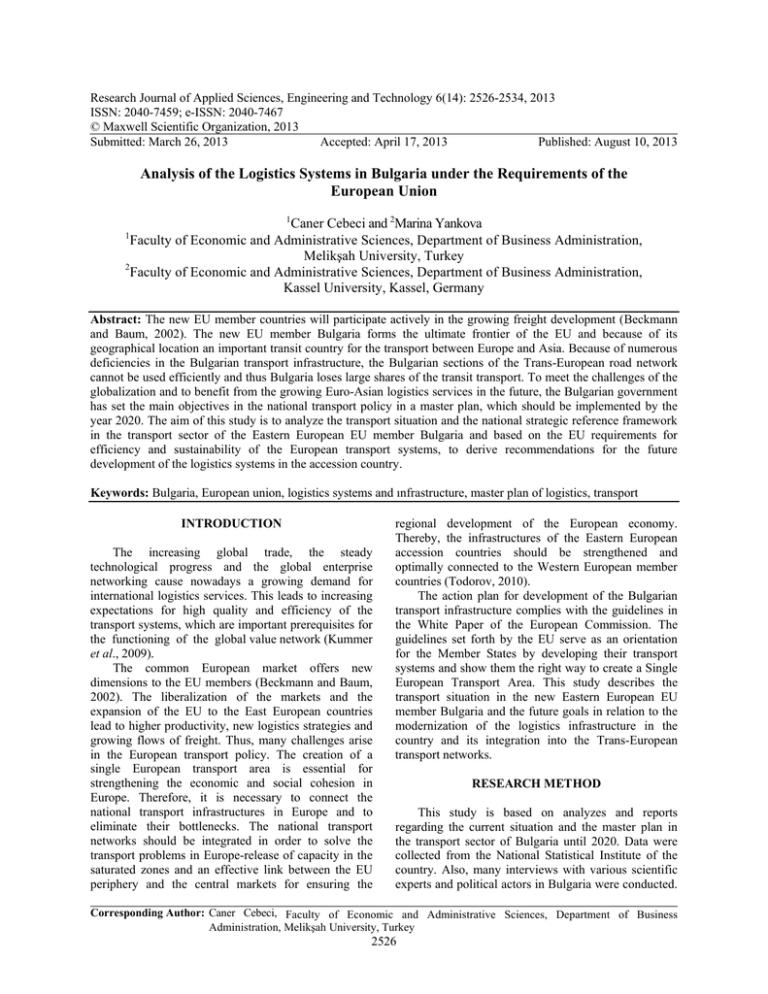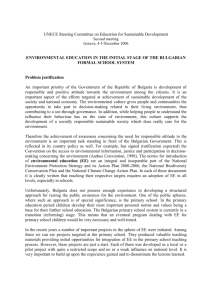Research Journal of Applied Sciences, Engineering and Technology 6(14): 2526-2534,... ISSN: 2040-7459; e-ISSN: 2040-7467
advertisement

Research Journal of Applied Sciences, Engineering and Technology 6(14): 2526-2534, 2013 ISSN: 2040-7459; e-ISSN: 2040-7467 © Maxwell Scientific Organization, 2013 Submitted: March 26, 2013 Accepted: April 17, 2013 Published: August 10, 2013 Analysis of the Logistics Systems in Bulgaria under the Requirements of the European Union 1 Caner Cebeci and 2Marina Yankova Faculty of Economic and Administrative Sciences, Department of Business Administration, Melikşah University, Turkey 2 Faculty of Economic and Administrative Sciences, Department of Business Administration, Kassel University, Kassel, Germany 1 Abstract: The new EU member countries will participate actively in the growing freight development (Beckmann and Baum, 2002). The new EU member Bulgaria forms the ultimate frontier of the EU and because of its geographical location an important transit country for the transport between Europe and Asia. Because of numerous deficiencies in the Bulgarian transport infrastructure, the Bulgarian sections of the Trans-European road network cannot be used efficiently and thus Bulgaria loses large shares of the transit transport. To meet the challenges of the globalization and to benefit from the growing Euro-Asian logistics services in the future, the Bulgarian government has set the main objectives in the national transport policy in a master plan, which should be implemented by the year 2020. The aim of this study is to analyze the transport situation and the national strategic reference framework in the transport sector of the Eastern European EU member Bulgaria and based on the EU requirements for efficiency and sustainability of the European transport systems, to derive recommendations for the future development of the logistics systems in the accession country. Keywords: Bulgaria, European union, logistics systems and ınfrastructure, master plan of logistics, transport INTRODUCTION The increasing global trade, the steady technological progress and the global enterprise networking cause nowadays a growing demand for international logistics services. This leads to increasing expectations for high quality and efficiency of the transport systems, which are important prerequisites for the functioning of the global value network (Kummer et al., 2009). The common European market offers new dimensions to the EU members (Beckmann and Baum, 2002). The liberalization of the markets and the expansion of the EU to the East European countries lead to higher productivity, new logistics strategies and growing flows of freight. Thus, many challenges arise in the European transport policy. The creation of a single European transport area is essential for strengthening the economic and social cohesion in Europe. Therefore, it is necessary to connect the national transport infrastructures in Europe and to eliminate their bottlenecks. The national transport networks should be integrated in order to solve the transport problems in Europe-release of capacity in the saturated zones and an effective link between the EU periphery and the central markets for ensuring the regional development of the European economy. Thereby, the infrastructures of the Eastern European accession countries should be strengthened and optimally connected to the Western European member countries (Todorov, 2010). The action plan for development of the Bulgarian transport infrastructure complies with the guidelines in the White Paper of the European Commission. The guidelines set forth by the EU serve as an orientation for the Member States by developing their transport systems and show them the right way to create a Single European Transport Area. This study describes the transport situation in the new Eastern European EU member Bulgaria and the future goals in relation to the modernization of the logistics infrastructure in the country and its integration into the Trans-European transport networks. RESEARCH METHOD This study is based on analyzes and reports regarding the current situation and the master plan in the transport sector of Bulgaria until 2020. Data were collected from the National Statistical Institute of the country. Also, many interviews with various scientific experts and political actors in Bulgaria were conducted. Corresponding Author: Caner Cebeci, Faculty of Economic and Administrative Sciences, Department of Business Administration, Melikşah University, Turkey 2526 Res. J. Appl. Sci. Eng. Technol., 6(14): 2526-2534, 2013 Important information regarding unfinished and planned infrastructure projects in Bulgaria are provided by the Ministry of Transport, Information and Communication Technology, the Ministry of Regional Development of the Republic of Bulgaria (2009) and the Bulgarian Council of Ministers. Other relevant information is provided by the Bulgarian Association for transport, forwarding and logistics and the University of National and World Economy in Sofia. The focus in the investigation is on the development of the freight transport. The EU internal market and the eastward expansion: The eastward enlargement plays an important role in the economic development of the European market and strongly influenced the European logistics market. The market liberalization, the freedom of cabotag*e in the EU and the elimination of tariff barriers cause increased production transfers in the Eastern European countries, an intensive international exchange of goods and drastic increases in the Transit Transport (Kummer et al., 2009). Through the integration policy of the European Union, the Eastern European countries can substantially improve their economic situation. But first they need to adapt themselves to the new challenges and to meet the complex requirements of the EU. The improvement of their logistics systems has therefore a central role for a rapid adaptation and achieving the economic level of the old EU members (Prog Trans, 2008). The European Commission's White Paper "Roadmap to a Single European Transport Area" includes the main goals in the developing of efficient transport systems in Europe. The guidelines are associated with the expansion, construction and maintenance of the transport infrastructure in the member countries and should be completed by 2050 (European Commission, 2011a). Particularly the Eastern European accession countries (Bulgaria and Romania) need strongly financial support and an adaptation period to develop their transport infrastructure in accordance with the EU requirements. To achieve the infrastructural level of the old Member States, they receive additional financial resources from the EU (Beckmann and Baum, 2002). The main objectives in the Transport White Paper of the European Commission are (European Commission, 2011b): • • • • • • • • • Creating an efficient intermodal transport network by linking all airports and seaports to the rail network Creating the framework conditions for the application of intermodal management systems in the European transport Comprehensive introduction of user financing and involving the private sector in the funding of the European transport infrastructure in order to eliminate distortions of competition and to ensure the fair financing of the infrastructure Harmonization of the security systems of the European rail networks through the use of ERTMS (European Rail Traffic Management System). The ERTMS system is currently regarded as a standardized control system that enables a smooth rail transport on the railway networks of Europe and minimizes the technical and organizational barriers in entering the different national rail markets. This standard system should be introduced in the EU by 2020 Improvement of the social conditions for workers in the transport sector and promotion of the education in order to create high-skilled jobs and to meet the increasing personnel demand in the transport sector Improvement of the existing and implementation of new control and enforcement rules for all transport modes in order to increase the security level in the transport sector and to strengthen the Europe's position in the field of transportation safety Increasing investment in the research and development activities and implementation of innovative concepts. BULGARIA-AN IMPORTANT TRANSIT COUNTRY The transport situation in Bulgaria: The accession of Bulgaria to the European Union, the free access to the European markets and the freedom of movement within the European area cause increasing rates of growth in the transport sector of the country. Given its geographical position as a transit country and the large number of trans-European transport corridors (the corridors IV, VII, VIII, IX, X), the country has good opportunities to become a major distribution center for international companies in the European and Asian markets (Evtimov, 2011). Figure 1 shows the Pan European transport corridors through Bulgaria. Relocation of 50% of the road transport on the Regarding the qualities of the national environmentally friendly transport (railway and infrastructure there is a lack of efficient transport waterway). Thus, the CO2 emissions can be networks in order to ensure a quick and safe mobility. reduced by about 60% until 2050 The coordination between the different modes of transport is inadequate and there is a lack of modern Tripling of the existing high-speed railway system systems for transport control. The transport modes have until 2030 and the completion of the system until different levels of development, which makes the 2050 2527 Res. J. Appl. Sci. Eng. Technol., 6(14): 2526-2534, 2013 Fig. 1: The Pan European transport corridors through Bulgaria (Dimitrov, 2009) competition in the transport market complicated. The degree of modernity of the road infrastructure is low, which leads to bottlenecks and risks in the transport management. The facilities and the technique, particularly in the rail and water transport, are outdated and that makes these transport modes unattractive. As a result these transport modes are used less and less. Because of the low transport volumes often arise an infrastructure overcapacity, which complicates the financing of the transport infrastructure. Also, there are missing administrative and technical capacity for managing large infrastructure projects, which leads to enormous delays of the project implementation. For example, the construction of the Danube Bridge “VidinCalafat” took ten years and the construction of a 19 km long highway section-6 years (Dimitrov, 2009). Of all transport modes, the railway transport in Bulgaria is in the worst condition. A substantial part of the railways was built more than 50 years ago and their technical parameters, design and facilities are suitable for speeds up to 100 km/h. On many railroads major repairs undergo for years, which make the working processes of the railway companies difficult (Ministry of Transport, Information and Communication Technologies of the Republic of Bulgaria, 2010). The overdue repairs on the railway lines lead to a further deterioration of the technical condition and the reliability of the security systems. The overdue repairs represent 2,450 km or 67.5% of the total length (3629 km total length) of the main railway lines (Bulgarian council of Ministers, 2011). The obsolete security systems and telecommunications facilities lead to frequent transport disruptions and endanger the safety of the railways (Ministry of Transport, Information and Communication Technologies of the Republic of Bulgaria, 2009). The Danube is the only waterway in Bulgaria and participates in the general system of the European inland waterways (the Trans-European Corridor VII). Rhine, Main and Danube connect Western and Eastern Europe (through the Rhine-Main-Danube Canal) and enable direct links between the Black Sea and the North Sea and water-access to many European countries and their industrial centers. Currently, there are numerous bottlenecks along the Bulgarian section of the Danube. The problems are particularly associated with the erosion of the shore and the lower depth in certain sections of the river. The condition of the port facilities is poor and the technology does not meet the current standards. Often there is a risk of accidents because the 2528 Res. J. Appl. Sci. Eng. Technol., 6(14): 2526-2534, 2013 number of the modern navigation and information systems is unsatisfactory (Dimitrov, 2009). Due to their geographical position at the crossroads between Europe and Asia, the ports of Varna and Burgas are included in the EU's concept for development of the Trans-European transport corridors. The ports enable a direct connection to the ports on the Trans-European transport corridors IX, X and VIII. Given the quality of the port infrastructure, the Bulgarian seaports are in poor condition due to the lack of modern communication and information systems and adequate investment for modernization and maintenance of the infrastructure. The large number of Trans-European transport corridors through Bulgaria (IV, VII, VIII, IX and X) opens up new potentials for development of the intermodal transport in this region. But currently all existing intermodal terminals are underused. Also, there are no logistical connections between the rail and sea transport and the most cargo handling terminals in Bulgaria are not equipped with the necessary technology for joint transport (Evtimov, 2011). MASTER PLAN FOR DEVELOPMENT OF THE LOGISTICS SYSTEMS IN BULGARIA BY 2020 For eliminating the technical and organizational barriers and securing the sustainability of the logistics systems in Bulgaria, a strategic action plan for development of the Bulgarian transport sector was created in 2007. The plan is fully in accordance with the EU requirements for international transport and will be implemented by 2020. The strategic measures in the Bulgarian transport sector until 2020 aim to ensure the economic efficiency by strengthening the competitiveness of the Bulgarian transport system and Fig. 2: Prioritizing projects for expansion and modernization of road infrastructure (Ministry of Transport, Information and Communication Technologies of the Republic of Bulgaria, 2006a, b) 2529 Res. J. Appl. Sci. Eng. Technol., 6(14): 2526-2534, 2013 to create framework conditions for sustainable growth in the national and international transport (Ministry of Transport, Information and Communication Technologies of the Republic of Bulgaria, 2009). • • • • combined transport in accordance with the EU requirements. The focus is currently on the creation of a combined transport network, which covers the Pan European corridors. With the support of EU many projects for the construction of intermodal terminals in the largest cities of Bulgaria are planned. Thus, major intermodal connections will be created with the logistics centers in Bulgaria (Ministry of Transport, Information and Communication Technologies of the Republic of Bulgaria, 2009). Measures for reducing the CO2 emissions in the transport sector: The Bulgarian transport policy focuses on the introduction of European standards regarding the CO2 emissions and the development of ecological requirements and tax reductions for the purchase of environmentally friendly vehicles to stimulate the market for eco-friendly vehicles and to increase the market share of biofuels to 10% by 2020 (Ministry of Transport, Information and Communication Technologies of the Republic of Bulgaria, 2007). Further goals for reducing the negative impacts of the transport on the environment, climate and life quality are the increase of the shares of environmentally friendly transport modes. Exploiting the potential of the different modes by shifting the shares of the road transport on the environment-friendly transport modes (rail and water transport) is one of the most effective measures for reducing the environmental and climate damages (Ministry of Transport, Information and Communication Technologies of the Republic of Bulgaria, 2009). Pipeline projects: The construction of a gas distribution network in Bulgaria is still in an early stage. Bulgaria is currently planning to start construction of international pipeline connections with the neighboring countries (Greece, Romania, Serbia and Turkey) to increase the transfer capacity of the existing pipelines with Russia. In December 2012, begins the construction of the "South Stream" pipeline in the Black Sea, which will run from the Russian city of Anapa to the Bulgarian coast (Varna) and will deliver 63 billion cubic meters of gas to Southern Europe per year. Improvement of the road infrastructure along the Trans-European Transport Corridors through Bulgaria: The largest infrastructure projects in the country relate in particular to the modernization of the transport infrastructure along the Trans-European transport corridors through Bulgaria to ensure a smooth transit transport. • Figure 2 shows the Prioritizing projects for expansion and modernization of road infrastructure. Measures in the rail transport: Through the improvement of the rail infrastructure the Bulgarian transport policy aims to achieve the quality standards in the EU for ensuring the railway interoperability. An important goal for improving the national rail infrastructure is to increase its productivity and to reduce the infrastructure costs. The Bulgarian government currently uses best practices from other EU member states to develop well-adjusted schedules, to improve the railway connections with the neighboring countries, to decrease the border crossings necessary time, to create an appropriate infrastructure and framework conditions for the container and combined transport and thus to ensure the high quality of the national rail infrastructure. The expansion of the railway infrastructure should ensure quality services for the conventional and combined transport and should • guarantee smooth transport processes at the ports of the Black Sea and the Danube up to the port of Thessaloniki (Greece) (Ministry of Transport, Information and Communication Technologies of the Republic of Bulgaria, 2010). Figure 3 shows the prioritizing projects for modernization of the railway infrastructure. Measures for strengthening the maritime: The tasks of the transport policy in the field of the inland waterways mainly include the elimination of bottlenecks along the Danube, the modernization of the port infrastructure, the renovation of the available fleet and the application of modern Bulgaria participates actively in the international information and communication technologies, to project "Nabucco". The project will enable the provide rapid and reliable services and to increase transportation of natural gas from the Caspian region, the transit transport along the Bulgarian part of the corridor VII (Ministry of Transport, Information the Middle East and North Africa to South-East Europe and Communication Technologies of the Republic and the European Union. The "Nabucco" pipeline will of Bulgaria, 2009). pass through Turkey, Bulgaria, Romania, Hungary and Measures for strengthening the intermodal Austria and will have a maximum transfer capacity of transport: One of the main goals of the Bulgarian 31 billion cubic meters. The construction of the pipeline transport policy is the future development of the is one of the most important EU projects for the future 2530 Res. J. Appl. Sci. Eng. Technol., 6(14): 2526-2534, 2013 Fig. 3: Prioritizing projects for modernization of the railway infrastructure (Ministry of Transport, Information and Communication Technologies of the Republic of Bulgaria, 2006) energy supply of Europe (Ministry of Economy, Energy and Tourism of the Republic of Bulgaria, 2011). • Bulgarian transport infrastructure requires a combination of different financial models. The funding sources for the improvement of the logistics systems in the country come from the budget, the Structural and Cohesion Funds of the EU and the income from charges for use of the infrastructure. Other resources come from bank credits from various international financial institutions. The European Bank for Reconstruction and Development (EBRD), the European Investment Bank (EIB), the World Bank (WB), the Japan Bank for International Cooperation (JIBIC) and the PHARE and ISPA programs support the infrastructural projects in Bulgaria (Todorov, 2010). Road safety measures: The Bulgarian government aims to introduce international and European standards for safety and security of all transport modes and to strengthen the monitoring of these standards. The technical system integration and the application of risk assessment methods are important tools for achieving a high level of safety in the transport sector (Ministry of Transport, Information and Communication Technologies of the Republic of Bulgaria, 2009). The security improvement in the national transport system will have a positive effect on the demand for transport services at national, regional and European level. This priority is in accordance with the guidelines of the European transport policy for security and protection of the life and health of the road users. • Financing of the infrastructure projects in Bulgaria: The modernization process of the RECOMMENDATIONS FOR THE FURTHER DEVELOPMENT OF THE LOGISTICS SYSTEMS IN BULGARIA The analysis of the transport situation and the strategic master plan for improving the logistics system in Bulgaria shows that Bulgaria should go through a 2531 Res. J. Appl. Sci. Eng. Technol., 6(14): 2526-2534, 2013 long process in order to achieve the development level of the Western European member states and to meet the EU requirements for efficient and sustainable logistics systems. The main actors in the development of the logistics systems in the country are the companies, the associations, the educational institutions and the government, which should work closely with each other and implement together the national transport policy. The following recommendations can contribute to increase the attractiveness and competitiveness of the logistics systems in Bulgaria: • Promotion of logistics organizations and associations and networking between the stakeholders in the logistics sector: The logistics organizations play a very important role in the shaping of the transport policy. They provide important information in relation to the transport development, represent the governmental interests and have a major impact on the transport policy decisions. In Bulgaria, there is currently only one association for transport and logistics, which deals with the existing transport problems in the country. The increased promotion of associations and organizations in the logistics sector, which prepares transport relevant data and develop analyses and forecasts, as well as their involvement in the national transport policy, are urgently needed to share experiences and to get important information. The information obtained can be discussed then with the different stakeholders through workshops and "round tables" in order to develop optimal solution paths In consequence of the lack of knowledge there are no specialists in this field. Through the creation of highquality study programs and through the enrichment of the teaching content in the universities, the students will acquire sound knowledge in logistics. Thus, they will be intensively prepared for the further career path, to later put their knowledge into practice. An important measure for obtaining knowledge in the academic fields is the collaboration with foreign universities from countries with traditions in the transport and logistics sector (such as Netherlands, Germany, etc.), their experiences can help to improve the programs of the Bulgarian educational institutions. The promotion of education and training in logistics should not be only a responsibility for the universities, but also for the companies. Through a wide range of seminars and trainings, the companies should support the development of young professionals and specialists and offer their staff qualification opportunities. • • The associations should also work closely with European organizations, participate in international trade fairs and actively market the logistics location in Bulgaria. Thus, the foreign investors can gain a comprehensive overview of the major potential of the logistics systems in Bulgaria. • Gaining of know how in logistics and promotion of training programs and further education: The use of the best-practices should be carried out by competent and experienced professionals. In this sense, the Bulgarian government should create the necessary conditions in order to gain logistics experts from abroad and prepare such experts in Bulgaria. The educational institutions should provide the knowledge in the logistics sector. Currently, only one university in Bulgaria offers a logistics degree program. Strengthening of research and development: Because of a lack of funding the research and development in Bulgaria is seriously neglected (Todorov, 2010). In this context, the Bulgarian government should provide the necessary financing for research and development, collaborate with international organizations and support the investigation of environmentally friendly transport modes, energy efficient technologies and alternative energy sources. Acceleration of the work processes and effective use of the EU funding: Despite the EU membership in Bulgaria, legal frameworks which correspond to the European standards are still missing. As a consequence, uncertainty arises in the planning and this leads to investment barriers. The insufficient financing, the bureaucratic behavior and the lack of administrative capacity and experience in the project preparation and processing cause enormous delays in the project implementation. In particular, the implementation of major projects such as the construction of highways takes decades. In addition, the project consulting and the qualification of professionals are urgently needed in order to optimize the working processes. In order to establish an efficient administrative system the Bulgarian Government should create transparent frameworks and set precise deadlines for the different project phases and reduce the large number of approval regulations in the project management. Not only the bureaucracy, but also the corruption in the use of the EU funding should be eliminated. The 2532 Res. J. Appl. Sci. Eng. Technol., 6(14): 2526-2534, 2013 government should create a reliable legal framework to ensure the planning security and the project implementation. The creation of anti-corruption mechanisms, the strengthening of the control and sanction regulations and the regular information providing can contribute to more transparency in the work processes and the fight against corruption in the management of EU funds. • Ensuring sufficient financial resources for the implementation of infrastructure projects and the involvement of private partners: Given the enormous investment needs for modernization of the Bulgarian infrastructure the financial resources provided by the Structural and Cohesion Fund are not sufficient for implementation of all planned activities. For securing an adequate financing the national transport policy should focus on the obtaining Bulgarian and foreign investors and operators in the transport sector and on the wider use of public-private partnerships. The involvement of the private sector is of high importance for the short-term provision of financial resources for the infrastructure and for the acceleration of the modernization processes in the transport sector. Through the implementation of appropriate measures and especially through the elimination of corruption and bureaucracy in the administrative system, the government should create incentives for private investors and stimulate their interest in the logistics location Bulgaria. CONCLUSION The analysis of the Bulgarian logistics systems has shown that for the planning and implementation of the concepts and support programs in the national transport sector are required considerable time, financial and technical resources. Especially the finance field represents a big hurdle for the development of efficient logistics systems in Bulgaria. Therefore, the important questions are how the financing gap in Bulgaria can be closed in order to implement the infrastructural measures qualitatively and on time and how can Bulgaria be more attractive as an investment location. These open questions will be subject of future studies. REFERENCES European Commission, 2011b. EUR-Lex-White Paper Roadmap to a Single European Transport Area: Towards a Competitive and Resource Efficient Transport System. Retrieved from: http://eurlex. europa.eu/LexUriServ/LexUriServ. do?uri = COM: 2011: 0144: FIN: DE: PDF, (Accessed on: June 05, 2012). Evtimov, S., 2011. Report on the Perspectives and Opportunities for Development of Multimodal Transport in Bulgaria. Sofia. Kummer, S., J.H. Schramm and I. Sudy, 2009. International Transport and Logistics Management. Facultas Publishing House, Vienna. Ministry of Economy, Energy and Tourism of the Republic of Bulgaria, 2011. The Energy Projects in Bulgaria. Retrieved from: http://www.mi.govern ment. bg/bg/themes-c91.html, (Accessed on: June 13, 2012). Ministry of Regional Development of the Republic of Bulgaria, 2009. Road Infrastructure. Retrieved from: http://www.mrrb.government.bg/, (Accessed on: June 01, 2012). Ministry of Transport, Information and Communication Technologies of the Republic of Bulgaria, 2006a. www.mtitc.government.bg/ Railway infrastructure in Bulgaria. Retrieved from: http://www. mtitc. government.bg/ upload/ docs/NI_12_EN_Rail.pdf, (Accessed on: July 15, 2012). Ministry of Transport, Information and Communication Technologies of the Republic of Bulgaria, 2006b. www.mtitc.government.bg/ Road infrastructure in Bulgaria. Retrieved from: http://www. mtitc. government.bg/upload/docs/NI_13_EN_Road.pdf, (Accessed on: July 15, 2012). Ministry of Transport, Information and Communication Technologies of the Republic of Bulgaria, 2006c. www.optransport.bg/ The operational Program Transport 2007-2013. Retrieved from: http://www. optransport.bg/upload/docs/OP_Transport_First_ Modification_2011.pdf, (Accessed on: June 15, 2012). Ministry of Transport, Information and Communication Technologies of the Republic of Bulgaria, 2006d. www.mtitc.government.bg/ The Pan European transport corridors through Bulgaria. Retrieved from:http://www.mtitc.government.bg/upload/ do cs/NI_1_EN_Corr.pdf, (Accessed on: July 22, 2012). Ministry of Transport, Information and Communication Technologies of the Republic of Bulgaria, 2007. www.mtitc.government.bg/ Program for promoting the consumption of biofuels 2008-2020. Retrieved from: http://www.mtitc.government.bg/ upload/ docs/Biofuels_Program_final. Pdf, (Accessed on: July 02, 2012). Beckmann, K. and H. Baum, 2002. Integrated transport policy: Report of the German Ministry of Transport. Building and Housing, Berlin. Dimitrov, V., 2009. The logistics-Present and Future. IBIS-Publishing House, Sofia. European Commission, 2011a. Europa Press ReleasesTransport 2050. Retrieved from: http://europa. eu/rapid/ press-release_IP-11-372_de. Htm, (Accessed on: April 06, 2012). 2533 Res. J. Appl. Sci. Eng. Technol., 6(14): 2526-2534, 2013 Ministry of Transport, Information and Communication Technologies of the Republic of Bulgaria, 2009. Strategy for Development of the National Transport Infrastructure by 2020. Retrieved from: http://www. mtitc. government. bg/page.php?cate gory = 451&id = 3756, (Accessed on: June 03, 2012). Ministry of Transport, Information and Communication Technologies of the Republic of Bulgaria, 2010. www.optransport.bg/The operational program Transport 2007-2013. Retrieved from: http:// www.optransport.bg/. (Accessed on: 21.07.2012) Prog Trans, A.G., 2008. East West Freight Transport 2030: Analysis, Forecasting and Challenges for the Transport Policy in Germany and Selected European Countries. Institute for Mobility Research, Basel. Todorov, F., 2010. The need of implementation of major infrastructure projects in Bulgaria. Report Commissioned by the Ministry of Transport, Sofia. 2534





